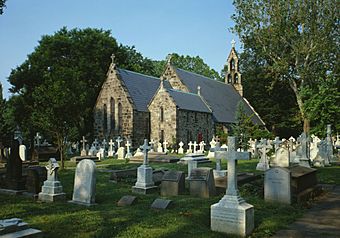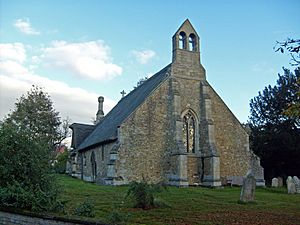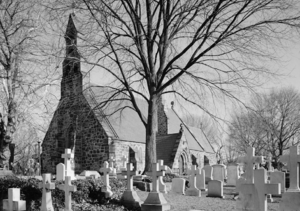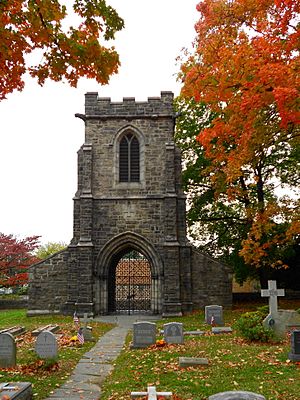Church of St. James the Less facts for kids
|
St. James-the-Less Episcopal Church
|
|
 |
|
| Location | Hunting Park Ave. at Clearfield St. Philadelphia, Pennsylvania |
|---|---|
| Built | 1846 |
| Architect | George Gordon Place, John E. Carver |
| Architectural style | Gothic Revival |
| NRHP reference No. | 74001801 |
Quick facts for kids Significant dates |
|
| Added to NRHP | November 20, 1974 |
| Designated NHL | February 4, 1985 |
The Church of St. James the Less is a very old church in Philadelphia, Pennsylvania. It is an Episcopal church, which is a type of Christian church. This church is famous for its special design, which influenced many other churches built after it.
Because of its unique Gothic Revival architecture, the church was named a National Historic Landmark. This means it's a very important historical place in the United States.
Contents
History of the Church
A kind and wealthy man named Robert Ralston wanted to start a church near his land. He passed away shortly before the church was founded. His friend, Samuel Jarvis, helped start the General Theological Seminary in New York. Samuel knew about a group called the Cambridge Camden Society.
The church community officially joined the Episcopal Diocese of Pennsylvania on May 22, 1846. On September 26, 1846, they chose the name "Rector, Church Wardens and Vestrymen of St. James the Less." The new church bought land from the nearby Laurel Hill Cemetery. They wanted to build a church that could welcome everyone. This included rich families living in big houses and working-class people from the nearby industrial area, now called Allegheny West.
The church was known for its traditional practices. At first, it used candles for light. Later, around 1885, oil lamps were used instead. In the early 1900s, the church became even more modern. A tall tower and chimes were added in 1910. Electric lights and central heating were also installed around 1913.
Church Architecture
The Church of St. James the Less was added to the National Register of Historic Places in 1974. It became a National Historic Landmark in 1985. The National Park Service said it was "the first example of the pure English Parish church style in America." They also called it one of the best 19th-century American Gothic churches. Its design greatly influenced other architects who built churches in the Gothic Revival style.

The church's Gothic architecture style happened almost by chance. The church leaders asked the Cambridge Camden Society for help with their design. This group was formed by students from Cambridge University. They loved Gothic architecture and wanted to combine it with church improvements. By mistake, the society sent detailed drawings of St. Michael's Church in England. This church was built around 1230. The builders of St. James the Less followed these drawings exactly. Architect John E. Carver oversaw the building process.
Later American churches were influenced by St. James' design. These include All Saint's Memorial Church (Navesink, New Jersey) and St. Peter's Episcopal Church (Neligh, Nebraska).
The church is built on the edge of a hill. It is north of Mount Vernon Cemetery and east of Laurel Hill Cemetery. Even though a busy road and industrial buildings are nearby, the churchyard is a peaceful green space in the city.
The Wanamaker Memorial Bell Tower and mausoleum were built in 1908. They were designed by John T. Windrim. The tower holds special chimes and bells. A parish hall, which later became the parish school, was built across the street.
The Church Today
The church faced some challenges over the years. Eventually, the Episcopal Diocese of Pennsylvania took control of the property. In 2008, another historic church, St. Mark's Church in Philadelphia, decided to help St. James the Less. St. Mark's adopted St. James the Less as a "mission church." This meant they would help keep it going. Weekly services, called Mass, started again on Sundays at 5:00 pm.
The School at St. James
The original parish school closed around 2006. As part of their plan, St. Mark's Church started raising money to open a new school. This school would serve the local community. In 2009 and 2010, the St. Mark's church community helped run a summer Bible school at the historic church.
In the fall of 2010, a successful after-school program began. Staff were hired, and renovations started. In September 2011, the Saint James School officially opened. It teaches students from grades 5 to 8. The school is part of the NativityMiguel Network of Schools and the National Association of Episcopal Schools.
Notable People Buried Here
The churchyard around St. James the Less is a cemetery. Many important people are buried there. The cemetery is usually open to the public on weekdays when the school is in session. It is also open on weekends during school events.
Here are some of the notable people buried at St. James the Less:
- Chapman Biddle (1822–1880), a Civil War Union Army officer.
- Horace Binney (1780–1875), a US Congressman.
- F. Carroll Brewster (1825–1898), a famous lawyer and judge from Philadelphia.
- Constance Dallas (1902–1983), the first woman elected to the Philadelphia City Council.
- James Barnet Fry (1827–1894), a Civil War Union brigadier general.
- John R. Goldsborough (1809–1877), a Civil War Union naval officer.
- Henry Ustick Onderdonk, the second bishop of the Episcopal Diocese of Pennsylvania.
- John Grubb Parke (1827–1900), a Civil War Union Major General.
- William Stevens Perry (1832–1898), a historian and president of Hobart College.
- Walter Elmer Schofield (1867–1944), an American Impressionist painter.
- Anthony Taylor (1837–1894), a Civil War Medal of Honor Recipient.
- Martin Russell Thayer (1819–1906), a US Congressman.
- Benjamin Chew Tilghman (1821–1901), a Civil War Union general and inventor of sandblasting.
- Stephen Decatur Trenchard (1818–1883), a United States Navy Rear-Admiral.
- John Wanamaker (1838–1922), a famous businessman who founded Wanamaker's Department Stores. He was also a Postmaster General.
- (Lewis) Rodman Wanamaker (1863–1928), John Wanamaker's son, who was a philanthropist and supported the arts.
Images for kids






